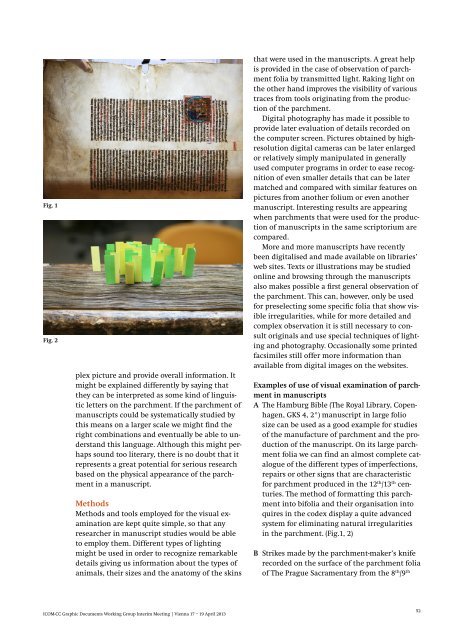Paper Conservation: Decisions & Compromises
Paper Conservation: Decisions & Compromises
Paper Conservation: Decisions & Compromises
Create successful ePaper yourself
Turn your PDF publications into a flip-book with our unique Google optimized e-Paper software.
Fig. 1<br />
Fig. 2<br />
plex picture and provide overall information. It<br />
might be explained differently by saying that<br />
they can be interpreted as some kind of linguistic<br />
letters on the parchment. If the parchment of<br />
manuscripts could be systematically studied by<br />
this means on a larger scale we might find the<br />
right combinations and eventually be able to understand<br />
this language. Although this might perhaps<br />
sound too literary, there is no doubt that it<br />
represents a great potential for serious research<br />
based on the physical appearance of the parchment<br />
in a manuscript.<br />
Methods<br />
Methods and tools employed for the visual examination<br />
are kept quite simple, so that any<br />
researcher in manuscript studies would be able<br />
to employ them. Different types of lighting<br />
might be used in order to recognize remarkable<br />
details giving us information about the types of<br />
animals, their sizes and the anatomy of the skins<br />
that were used in the manuscripts. A great help<br />
is provided in the case of observation of parchment<br />
folia by transmitted light. Raking light on<br />
the other hand improves the visibility of various<br />
traces from tools originating from the production<br />
of the parchment.<br />
Digital photography has made it possible to<br />
provide later evaluation of details recorded on<br />
the computer screen. Pictures obtained by highresolution<br />
digital cameras can be later enlarged<br />
or relatively simply manipulated in generally<br />
used computer programs in order to ease recognition<br />
of even smaller details that can be later<br />
matched and compared with similar features on<br />
pictures from another folium or even another<br />
manuscript. Interesting results are appearing<br />
when parchments that were used for the production<br />
of manuscripts in the same scriptorium are<br />
compared.<br />
More and more manuscripts have recently<br />
been digitalised and made available on libraries’<br />
web sites. Texts or illustrations may be studied<br />
online and browsing through the manuscripts<br />
also makes possible a first general observation of<br />
the parchment. This can, however, only be used<br />
for preselecting some specific folia that show visible<br />
irregularities, while for more detailed and<br />
complex observation it is still necessary to consult<br />
originals and use special techniques of lighting<br />
and photography. Occasionally some printed<br />
facsimiles still offer more information than<br />
available from digital images on the websites.<br />
Examples of use of visual examination of parchment<br />
in manuscripts<br />
A The Hamburg Bible (The Royal Library, Copenhagen,<br />
GKS 4, 2°) manuscript in large folio<br />
size can be used as a good example for studies<br />
of the manufacture of parchment and the production<br />
of the manuscript. On its large parchment<br />
folia we can find an almost complete catalogue<br />
of the different types of imperfections,<br />
repairs or other signs that are characteristic<br />
for parchment produced in the 12 th /13 th centuries.<br />
The method of formatting this parchment<br />
into bifolia and their organisation into<br />
quires in the codex display a quite advanced<br />
system for eliminating natural irregularities<br />
in the parchment. (Fig.1, 2)<br />
B Strikes made by the parchment-maker’s knife<br />
recorded on the surface of the parchment folia<br />
of The Prague Sacramentary from the 8 th /9 th<br />
ICOM-CC Graphic Documents Working Group Interim Meeting | Vienna 17 – 19 April 2013<br />
52
















